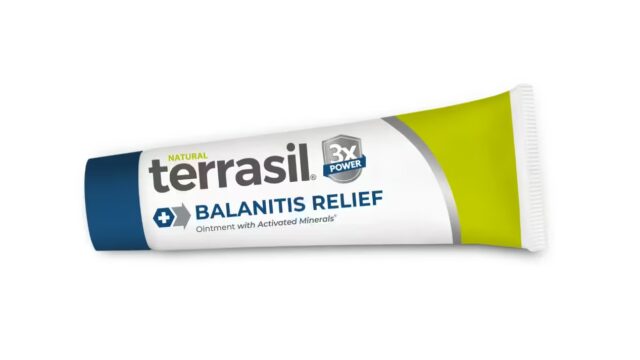Asking the Question: Do I Have Balanitis?
It’s not always easy to talk about discomfort in intimate areas. Many men notice redness, itching, or irritation but brush it off, hoping it will pass on its own. If you’ve found yourself wondering, “Do I have balanitis?” you’re not alone.
Balanitis is the inflammation of the glans (head) of the penis. When the foreskin is also involved, it’s called balanoposthitis. Though it can feel embarrassing to discuss, balanitis is relatively common—accounting for up to 11% of urology visits among uncircumcised men . The good news? In most cases, simple daily care and attention to triggers can go a long way in supporting comfort.
What Causes Balanitis in Men?

Understanding the causes of balanitis is important because it helps you prevent flare-ups in the future. Many men assume it’s only linked to hygiene, but the reality is more complex. Skin in intimate areas is delicate, and when daily habits, health conditions, or environmental factors disrupt its balance, irritation can develop.
Here are some of the most common reasons balanitis may occur:
- Moisture buildup: Sweat, urine residue, or trapped dampness under the foreskin may encourage irritation.
- Hygiene habits: Skipping regular cleansing can allow buildup, while over-scrubbing with harsh soaps or antibacterial gels may strip away natural oils.
- Medical conditions: Diabetes is a major risk factor, as higher blood sugar levels can affect the skin’s natural balance .
- Irritants and chemicals: Scented soaps, lubricants, and even certain laundry detergents may cause sensitivity.
- Everyday friction: Sexual activity, tight clothing, or vigorous exercise can sometimes lead to chafing and irritation.
Recognizing the Symptoms of Balanitis
Knowing what balanitis looks and feels like is the first step to addressing it early. Symptoms vary in intensity, but they often share common signs that are hard to ignore once you’re aware of them. Paying attention to changes in the look, feel, or smell of intimate skin can help you spot problems sooner and take action before things get worse .
Here are the most frequent symptoms men report:
- Redness or inflammation at the tip of the penis
- Swelling or puffiness of the glans
- Itching, soreness, or burning sensations
- Shiny, stretched-looking skin
- Clear or whitish buildup beneath the foreskin
- Odor that seems stronger than usual
- Discomfort during urination or intimacy
Who Is More Likely to Get Balanitis?

Not every man experiences balanitis, but certain groups are more prone to it. Understanding your risk level is helpful because it encourages prevention and self-awareness. If you know you fall into a higher-risk category, you can be more proactive about gentle hygiene and paying attention to early warning signs .
Groups that may be more likely to experience balanitis include:
- Uncircumcised men (foreskin can trap moisture)
- Men with diabetes (skin may be more prone to imbalance)
- Men with obesity (extra skin folds increase warmth and dampness)
- Men with sensitive skin (higher reactivity to soaps, detergents, or latex)
- Men with compromised immunity (reduced natural defenses)
When to See a Doctor

While many men can manage mild irritation at home, there are times when professional guidance is the safest choice. Knowing when to seek medical help prevents small issues from turning into bigger problems .
You should seek medical attention if:
- Symptoms last longer than 3–5 days without improvement
- Severe redness, swelling, or pain develops
- You notice pus, sores, or bleeding
- You develop fever or chills
- Flare-ups keep returning despite careful hygiene
- You have diabetes and notice frequent irritation
Practical Home-Care Tips

The skin in intimate areas is sensitive, but a few small daily changes can make a big difference. Simple routines often bring relief and help prevent future irritation .
Here are some of the most effective home-care steps:
- Rinse gently with lukewarm water or a mild, fragrance-free cleansing bar.
- Pat dry carefully with a clean, soft towel.
- Wear breathable fabrics like cotton underwear.
- Change damp clothes promptly after exercise or swimming.
- Avoid irritants like heavily perfumed soaps, powders, or wipes.
- Support overall health (such as balanced nutrition and blood sugar management for men with diabetes).
Gentle Relief Options

Sometimes, even with careful hygiene, you may want extra support for comfort. That’s when choosing products designed specifically for sensitive skin can be reassuring. Unlike harsh soaps or generic lotions, a routine tailored for delicate areas helps you feel confident without adding new irritants.
The Terrasil® Serious Balanitis Relief Kit provides a simple two-step routine:
- Mild cleansing bar — helps wash away buildup without harsh foaming agents or fragrances.
- Soothing ointment — formulated with:
- Comfrey extract, traditionally used for calming sensitive skin
- Patented Activated Minerals® technology, developed to support healthier-looking skin
- Botanical ingredients chosen to promote comfort and balance
Because intimate skin is delicate, using products designed for this purpose can give men peace of mind. Terrasil® products are manufactured in an FDA-registered facility and are free of unnecessary chemicals. Some users have reported feeling more comfortable within a few days, though experiences vary.
Myths vs. Truths About Balanitis
When you’re already uncomfortable, myths can make things worse by adding confusion or shame. Clearing up misconceptions helps you feel less alone and gives you confidence to make informed choices .
Myth: Only men with poor hygiene get balanitis.
Truth: Even men with good hygiene may develop irritation from diabetes, friction, or soaps.
Myth: Balanitis always means you have an STD.
Truth: Many cases are not sexually transmitted. Everyday skin factors often play a bigger role.
Myth: Circumcision is the only solution.
Truth: While circumcision may reduce risk, most men manage balanitis with simple daily care and supportive skin products.
Myth: It always clears up on its own.
Truth: Sometimes irritation improves, but persistent symptoms should be checked by a doctor.
FAQs About Balanitis
Final Thoughts

If you’ve been asking yourself, “Do I have balanitis?”, you’re not alone. The condition is common and manageable, and seeking answers is already a step toward relief.
By learning the symptoms, understanding risk factors, and making small hygiene adjustments, you can often help keep discomfort under control. And if you’re looking for added support, the Terrasil® Serious Balanitis Relief Kit provides a gentle two-step routine designed with sensitive skin in mind.
And remember: if symptoms don’t improve, talking to a healthcare provider is always the best next step.
References
- Edwards, S. (2019). Balanitis and balanoposthitis: A review. Journal of the European Academy of Dermatology and Venereology, 33(9), 1636–1643.
- Wray, A. A., & Velasquez, J. (2023). Balanitis. StatPearls Publishing. Available from: https://www.ncbi.nlm.nih.gov/books/NBK537143/
- Mayo Clinic. (2024). Balanitis: Symptoms and Causes. Retrieved from: https://www.mayoclinic.org/diseases-conditions/balanitis/
- Janier, M., et al. (2022). 2022 European guideline for the management of balanoposthitis. Journal of the European Academy of Dermatology and Venereology, 36(5), 725–733.
- NHS UK. (2023). Balanitis. Retrieved from:
https://www.nhs.uk/conditions/balanitis/
Safety Information
- Terrasil® products are regulated as over-the-counter skin care drug products.
- These statements have not been evaluated by the U.S. Food and Drug Administration.
- Products are not intended to diagnose, cure, mitigate, treat, or prevent any disease. Always consult a qualified healthcare professional if symptoms persist, worsen, or recur.







